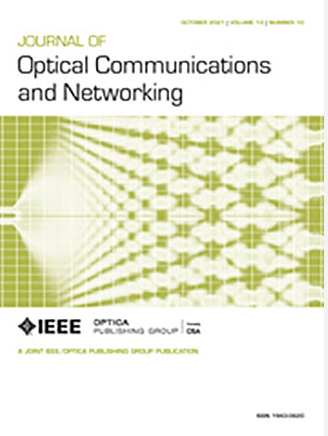QoT-aware multi-constraint routing in large-scale optical networks based on contraction hierarchies and propagation chains
IF 4.3
2区 计算机科学
Q1 COMPUTER SCIENCE, HARDWARE & ARCHITECTURE
引用次数: 0
Abstract
Multi-constraint routing is a crucial problem in optical networks, as establishing a lightpath must account for multiple constraints, including bandwidth demand, transmission delay, and quality of transmission (QoT). However, the problem-solving complexity increases exponentially due to the addition of constraints such as wavelength contiguity and optical nonlinearity as the network scale increases. Therefore, it is difficult to find a path that satisfies all optical constraints within 10 ms in large-scale topologies. To address these challenges, this paper proposes a QoT-aware multi-constraint routing (QaMcR) algorithm for large-scale optical networks. The algorithm utilizes a contraction hierarchy structure to simplify the topology and employs an enhanced Dijkstra strategy during the routing process, which comprehensively considers transmission delay, bandwidth requirements, and GSNR. Additionally, QaMcR dynamically updates bandwidth usage within the network with low overhead through the time-efficient propagation chain. We simulate both classical and 274-node topologies, using GNPy for physical layer modeling and QoT estimation. A total of基于收缩层次和传播链的大规模光网络中qot感知多约束路由
多约束路由是光网络中的一个关键问题,因为建立光路必须考虑多种约束,包括带宽需求、传输延迟和传输质量(QoT)。然而,随着网络规模的增加,由于波长连续性和光学非线性等约束的增加,问题的复杂性呈指数增长。因此,在大规模拓扑中,很难在10ms内找到满足所有光学约束的路径。为了解决这些问题,本文提出了一种用于大规模光网络的qot感知多约束路由(QaMcR)算法。该算法采用压缩层次结构简化拓扑结构,并在路由过程中采用增强的Dijkstra策略,综合考虑传输时延、带宽要求和GSNR。此外,QaMcR通过时间高效的传播链,以低开销动态更新网络内的带宽使用情况。我们模拟了经典拓扑和274节点拓扑,使用GNPy进行物理层建模和QoT估计。总共进行了$5 \ ×{10^8}$模拟,探索了近10亿条最短路径。结果表明,QaMcR算法可以在2 ms内找到满足多约束的时延最短的路径,在保证低时延和低阻塞率的前提下,将路由时间缩短95%。
本文章由计算机程序翻译,如有差异,请以英文原文为准。
求助全文
约1分钟内获得全文
求助全文
来源期刊
CiteScore
9.40
自引率
16.00%
发文量
104
审稿时长
4 months
期刊介绍:
The scope of the Journal includes advances in the state-of-the-art of optical networking science, technology, and engineering. Both theoretical contributions (including new techniques, concepts, analyses, and economic studies) and practical contributions (including optical networking experiments, prototypes, and new applications) are encouraged. Subareas of interest include the architecture and design of optical networks, optical network survivability and security, software-defined optical networking, elastic optical networks, data and control plane advances, network management related innovation, and optical access networks. Enabling technologies and their applications are suitable topics only if the results are shown to directly impact optical networking beyond simple point-to-point networks.

 求助内容:
求助内容: 应助结果提醒方式:
应助结果提醒方式:


